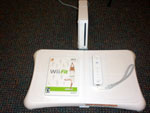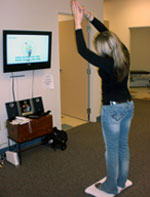|
PT Classroom - Utilization of the Nintendo Wii in Physical Therapy ׀ by Cari Kuehmichel, PT, CLT |

Cari Kuehmichel, PT, CLT, graduated from Marquette University in 1987. She has worked in acute care, nursing facilities, outpatient clinics, school services and home health. She has been the director of therapy services in several nursing homes, owner of a contract service, and most recently an owner of a private practice physical therapy clinic. She is well versed in orthopedics, geriatrics and a multitude of manual therapy techniques including craniosacral therapy. |
|
Utilization of the Nintendo Wii in Physical Therapy |
 As physical therapy professionals we have access to a
variety of equipment and tools which could be utilize in our
treatment sessions when treating patients. One such piece of
equipment that is low cost and becoming popular in physical
therapy clinics is the Nintendo Wii. As physical therapy professionals we have access to a
variety of equipment and tools which could be utilize in our
treatment sessions when treating patients. One such piece of
equipment that is low cost and becoming popular in physical
therapy clinics is the Nintendo Wii. The Nintendo Wii is an innovative and interactive gaming console which utilizes various controllers such as a nunchuck, a guitar, a balance board, etc. to simulate participation in functional activities such as sports, playing instruments, yoga, etc. The advantage of the Wii is that it can simulate functional based exercise which is an important aspect when developing therapeutic exercises for our patients so that they can regain function. In a case report by Deutsch et al. they utilized the Nintendo Wii for rehabilitation of an adolescent with cerebal palsy and found success in achieving gains with postural control, functional mobility and visual –perceptual processing (1). To the authors’ knowledge, this is the first published report on using the Wii to augment therapy for a person with CP.  Another advantage of the Wii is that it is low cost and can
allow physical therapists to help patients develop home
programs off of it. Through these home programs, therapists
can have their patients continue to work on range of motion,
strengthening, stabilization, stretching, balance, and
somatosensory / proprioceptive training. The variety of games available and the
ability to modify settings on these games also affords the
patient the ability to be continually challenged and
stimulated. Another advantage of the Wii is that it is low cost and can
allow physical therapists to help patients develop home
programs off of it. Through these home programs, therapists
can have their patients continue to work on range of motion,
strengthening, stabilization, stretching, balance, and
somatosensory / proprioceptive training. The variety of games available and the
ability to modify settings on these games also affords the
patient the ability to be continually challenged and
stimulated.As physical therapy professionals we should also realize that because of the growing popularity of the Wii, there has been an increase in injuries as the result of its use. The term given to these types of injuries are coined “Wiiitis”. As physical therapy professionals, it is just as important that we educate not only our patients but the community as well in order to prevent Wiitis. Nintendo gives the following recommendations in regards to the use of the Wii: WARNING - Repetitive Motion Injuries and Eyestrain Playing video games can make your muscles, joints, skin or eyes hurt. Follow these instructions to avoid problems such as tendinitis, carpal tunnel syndrome, skin irritation or eyestrain: • Avoid excessive play. Parents should monitor their children for appropriate play. • Take a 10 to 15 minute break every hour, even if you don't think you need it. • If your hands, wrists, arms or eyes become tired or sore while playing, or if you feel symptoms such as tingling, numbness, burning or stiffness, stop and rest for several hours before playing again. • If you continue to have any of the above symptoms or other discomfort during or after play, stop playing and see a doctor.
Last revised: July 8, 2009
|
|
|
|
|
Terms & Conditions
Please review our terms and conditions
carefully before utilization of the Site. The information on this Site is for
informational purposes only and should in no way replace a conventional visit to
an actual live physical therapist or other healthcare professional. It is
recommended that you seek professional and medical advise from your physical
therapist or physician prior to any form of self treatment.
Copyright 2005-2022 CyberPT Inc. All rights reserved.






